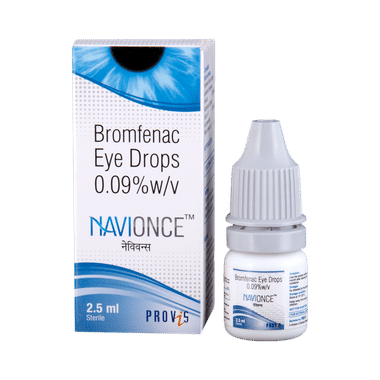

Bromfenac (0.09% w/v)
Always wash your hands before using Navionce Eye Drop. Use only the number of drops that your doctor has prescribed and wait for about five minutes between each drop. If you wear contact lenses, remove them before using the drops and wait for at least 15 minutes before putting them back in. You should not touch the tip of the dropper or bottle. This may lead to infection.Use of the medicine may cause blurred vision, increased sensitivity to light, change in color vision, decreased vision, eye pain, sore eyes, teary eye, and headache. These are usually temporary and resolve with time. However, if they persist or get worse, you should let your doctor know. Your doctor may be able to suggest ways of preventing or reducing the symptoms.Before using this medicine, you should tell your doctor about all the other medicines you are taking. You should also tell your doctor if you have any other medical conditions or disorders. Pregnant and breastfeeding women should consult with their doctors before using the medicine.
Most side effects do not require any medical attention and disappear as your body adjusts to the medicine. Consult your doctor if they persist or if you’re worried about themCommon side effects of Navionce
2.5 ml Eye Drop
Image shown is a representation and may slightly vary from the actual product. Every effort is made to maintain accuracy of all information displayed.
This medicine is for external use only. Use it in the dose and duration as advised by your doctor. Check the label for directions before use. Hold the dropper close to the eye without touching it. Gently squeeze the dropper and place the medicine inside the lower eyelid. Wipe off the extra liquid.
Navionce Eye Drop is a non-steroidal anti-inflammatory drug (NSAID). It works by stopping the release of certain natural substances in the eye that are responsible for pain and inflammation (redness and swelling).
Related Warnings
No interaction found/established
Navionce Eye Drop may be unsafe to use during pregnancy. Although there are limited studies in humans, animal studies have shown harmful effects on the developing baby. Your doctor will weigh the benefits and any potential risks before prescribing it to you. Please consult your doctor.
Navionce Eye Drop is probably safe to use during breastfeeding. Limited human data suggests that the drug does not represent any significant risk to the baby.
Navionce Eye Drop may cause blurring of your vision for a short time just after its use. Do not drive until your vision is clear.
No interaction found/established
No interaction found/established
Always wash your hands before (and after) using Navionce Eye Drop. This prevents you from passing the infection from one eye to the other. Remove the cap just before using your medicine and replace it as soon as you have finished. Avoid touching the nozzle of the bottle with your fingers. Tilt your head back and gently pull down your lower eyelid with a clean finger. Hold the bottle over the eye and allow a single drop to fall into the space between your lower lid and your eye. Close your eye and gently press your finger over the inside corner of your eye (over the eyelid) for about a minute. This helps prevent the drop from draining out of the eye. Repeat in your other eye if your doctor has told you to do this.
Instill one drop into the affected eye(s) once daily beginning 1 day prior to surgery, continued on the day of surgery, and through the first 14 days post-surgery. However, follow your doctor's instructions regarding dosage since it may vary from patient to patient.
You should contact your doctor immediately if you develop abnormal sensations in the eye, eye irritation (including burning/stinging), eye pain, eye allergy, eye redness, headache, and iritis (inflammation of the colored part of your eye).
Always consult your doctor before using any other eye drops along with Navionce Eye Drop. It is advisable to give a gap of atleast 5 minutes between the two medications.
Use of any other topical pain relieving medicine with Navionce Eye Drop may slow or delay healing of your operated eye. Consult your doctor in case of any doubts.